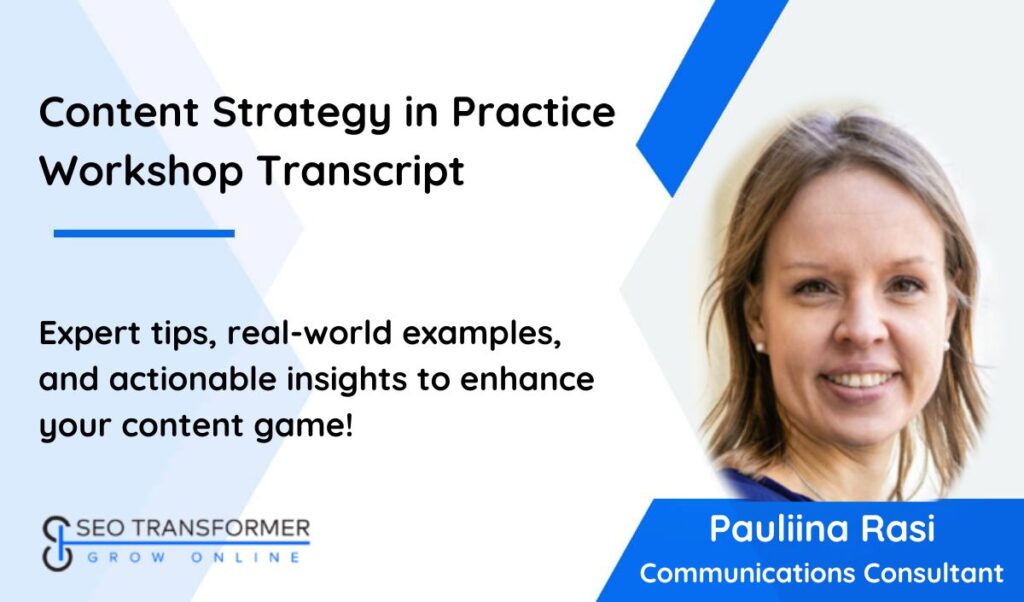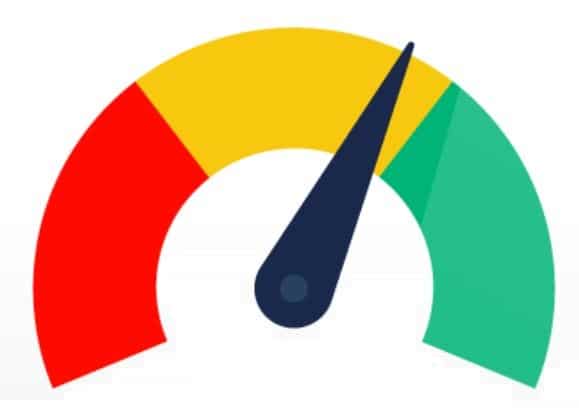Welcome to the SEO & Web Swiss Chapter. We are an online community launching workshops online. We regularly share best practices and tips about SEO, content, digital marketing, social media, and paid ads. You can find information about the upcoming workshops on our Community Events page.
About the Workshop and speaker
This workshop is hosted by SEO Transformer, a digital agency serving clients in Switzerland and abroad. We have experience working with international brands and multilingual websites, and are a one-stop shop for all your digital needs. We integrate best practices, technologies, and digital trends to support decision-making and maximize the chances for the best results. If you have questions or if you need help with any of your website issues, reach out at [email protected].
Our guest speaker, Pauliina Rassi, a content strategist, communications consultant and copywriter will be sharing with us practical and useful tips for managing your content, planning your content calendar and staying on top of your content production routine.
Pauliina talks about content strategy in practice so that, in a nutshell, you can create better content while working less and getting faster, better results for your business or for your organization.
To give you a little bit of context on how to turn your content to clients, or how to turn your content into driving an impact, there are three aspects or three ingredients that you will want to look at today: content strategy, creating interesting and engaging content, and quick and easy creative process.
1. Content Strategy
When we talk about content strategy and content marketing, having the right strategy in place is really crucial because before you know where you want to focus, what are you really working on? All your best projects and your most creative ideas might just fall through the cracks because they aren’t really, really helping you reach your goals. And we approach today’s content strategy through four basic questions that you should have clarity on.
What is the problem?
Which problem are you solving for your followers often in terms of a strategy, strategy, or communication strategy?
The second question is very, very tightly linked to the first one, and it is, who is that solution for? So who is or what is or what kind of companies, organizations, people, and professionals are you trying to reach? And these two questions are really at the heart of your content and communication strategy.
Often, people come with problems or questions like, “I’m not really getting engagement,” or “I’m actually not getting the traction I want,” “I’m not really getting the sales,” or “my audience isn’t growing.”
Often, when content and content marketing aren’t working for your business or for your company, the key to the solution is in the first two questions: what is the problem solving and for whom are you solving it?
Then with questions three and four, we get more practice. These are more technical and practical questions.
Question # 3: “Where and how do you grab your audience’s attention?”
So we come to a question. Questions about your channel’s publication frequency or your content. Like, where are you getting? What kind of content do you need to grab their attention? And finally, number four…
Question # 4: “When and how often do you communicate, communicate with them?” So again, three and four. They are linked to each other. What are your channels? What kind of content works on those channels, and when and how often do you want to reach their audience? What are the best times? What is the best frequency for your team as well?
After all, communications strategy can be very simple.
So if you feel like your strategy needs a little bit of clarification, that’s when it’s really getting the results that you want. Or, simply, it’s been a while since you last worked on your strategy, look back at these four questions.
What is the problem that you are solving for your audience? Who is that audience you want to reach, and how is your solution relevant to them? Which channels and content will you use to grab their attention? And when and how often do you want to communicate with them so that your content is still relevant to them? That it’s not too much, nor too little, but it just hits the sweet spot.
2. Engaging and Interesting Content
Now that you have your clinical strategy basics in place, we will look at five ways to turn that strategy into engaging and interesting content, especially for social media. This is often the biggest question. How can I get a wider reach? How can I get people to engage with my content, comments and share? How can I make it fun and interesting all while staying loyal to my key message, my branding, and especially with bigger, bigger, or more complex organizations, or while taking into account different stakeholders and different points of view that need to be disseminated and communicated?
There are five secret ingredients that really work well for clients and many mission organizations and businesses out there.
Secret Ingredient # 1: Creating a Recurring Content Structure
A recurring structure provides you with a schedule or a “rhythm” for posting your blogs, newsletters, or LinkedIn at a specific time. When you have this kind of structure in place, it makes your content planning, on the one hand, more strategic and, on the other hand, a lot faster because you don’t have to reinvent the wheel. Every time you sit down and start thinking about what kind of content you are going to put out next month, you already have that structure and you just then start filling in the missing pieces.
It is also quite flexible. Even though you have this structure and it’s a regular thing, you can shift it up when you need to. For example, if you usually have your blog articles every other week or your newsletters every other week, but during this period, you are launching something new, you are allowed to shift the schedule and play around.
But when you have a certain starting point and a default setting, in a way, it’ll make everything so much easier for you. And, then you can also focus on what really works for your business and what brings you results.
Secret Ingredient #2: Repurposing Content
The secret ingredient number two is content to repurpose. And this is often where there is a lot of potential, especially for one person, businesses or small teams to gain a lot of time and again be much more strategic with their content.
Content repurposing is that often we create one piece of content and then we kind of leave it there. We put all that thought and effort and time into creating that one big article or one podcast interview, or one really great social media post. But it really never goes further than that. When we are approaching repurposing strategically, we take that one piece of content and create many pieces around that.
You can do that in various ways: take a long-form blog and take one section to make an infographic, another to make a short blog, and yet another for a video. This keeps things interesting for your followers.
A really good way to repurpose content is to do all of these in one go. When you write a blog article, you can also create at least five other pieces of content from that blog article. In that way, it often makes the whole thing easier because the idea is still fresh in your head. You don’t have to come back to that and then reread or relisten to what you created. You can really just do it all in one go and start building that content back so that you may easily use and reuse and recycle that content as time goes by. It’s a really easy way to create strategic content for your brand.
Secret Ingredient # 3: Creating New Content
We tapped into this a little bit when we were looking at the content structure for the month. You can have that same kind of recurring system for all kinds of content.
You can write about newsletter email strategies. You can talk about adding gifts to your emails. You can create polls and make them short and engaging and easy so it’s easy for people to click.
One effective recurring content feature is videos where the people who control their programs share their experiences, which is, again, a nice, authentic, organic way to share what you do and how it benefits people without being too salesy.
You can also use carousels, which is a great feature on LinkedIn. You can create these carousels where people can browse through several slides or several visuals. So it’s a really great way to add a little bit more value than you can maybe fit in an individual graphic or a shorter post.
You can put it in an easy to consume format for the readers and keep it regular. It doesn’t need to be necessarily weekly or every other Monday, but it needs to be regular enough so that people can remember.
Secret Ingredient # 4: Remember to Use a Wild Card
When you have recognizable repetitive elements in your plan, it allows you to save time. It allows you to create a consistent, consistent content feed and create strategic content. But you want to save certain slots for something different or something fun. It can just be something spontaneous and one that you and your team do when you have a great idea. You can be a little bit tongue in cheek and fun and light every now and then, as long as it’s relevant for your brand, especially on LinkedIn, and when you’re communicating in the business context, you’re communicating for a business audience or for an educated audience. You don’t want to undermine them or underestimate them. So be relevant, be fun.
Secret Ingredient # 5: Engagement
This is part of the promotion cycle that we talked about at the very beginning. This is often a part that gets a little bit forgotten or omitted in content marketing strategy, because we often talk about what kind of content we want to put out there and how we will serve our audiences. And then we forget to follow up and engage. And you can, of course, engage in many, many different ways.
But stay relevant. Stay relevant. It’s not about just adding cat videos for the cat video’s sake, but really to make a point and connect with your audience. But create content that makes it easy for them to get in touch with you. And remember to stay active on the engagement side as well.
Participating in the discussion can help you to grow your reach as well.
3. Quick and Easy Creative Process
Let’s be honest. Most of us who have to create content consistently know that it takes time. As entrepreneurs, business owners, and professionals, we only have so many hours in the day. So today, we talk about creating content more quickly.
There are three tips to share with you today.
Tip # 1: Planning and Consistency
Planning, planning and planning. When you have a strategy in place, when you have a plan or the structure for the monthly content in place, you already have saved a lot of time.
To stay consistent means to make sure that you don’t create a lot of content during two weeks and then go completely missing for another two weeks.
You also need to plan for when you create content. It is a good idea to have at least one day per month to plan for the next month, depending on your time preference. You can also do it once a week for the whole way because it allows you to save time and stay consistent throughout the week as well.
Tip #2: Make Repurposing Habits
The second tip is to make repurposing habits. Here you can follow the secret tip of repurposing your content while you’re creating it, because it makes everything so much easier. And having that content bank then makes your weekly content creation very easy. It can make you spend as little as 20 minutes per week on your LinkedIn content, even though you may have 3 to 5 posts because of this repurposing habit. You can just go to your content bank and see what you already have there that is relevant. This way, you have to create less content on the go.
Tip #3: Involve a Wider Team
Even in small businesses where you may only have one person in communications, there’s a risk that your staff starts running in the same circles and you’re running around doing the same things again and again and again. And it’s a little bit of a downside of planning. So when you have your plans in place, you want to stick to them, but not too tightly. So things stay interesting for your audience as well. So enable the wider team to give you feedback.
Typically in businesses, salespeople have great content ideas because they are on the front line working with customers. They know their pain points, they know what they need help with, etc. or customer service as well. If you have a customer service representative or department, they can have amazing insights for your content as well. Even if you’re alone, you can pull up your resources. With other entrepreneurs, you can sometimes brainstorm for each other’s brands or do a joint brainstorming session where everybody pitches in for everybody else to get a little bit of fresh perspectives.
You can ask your audience as well for feedback and ideas every now and then, as well.
Fundamental SEO Best Practices Related to Content
In this part, Nadia Mojahed, SEO Expert and Founder of SEO Transformer, will be sharing some fundamental SEO best practices related to content.
Keyword Strategy
The most important part related to content is setting the keyword strategy based on user needs and business objectives. We are all familiar with search terms or keywords and that you need to select keywords relevant to your content with good search volumes in your target region.
When you have content you would like to write about, it’s very important to brainstorm a few seed keywords, of what users can be searching with to find your content.
Keyword selection example
For example, if you have a topic around Swiss chocolate, then your users might be searching for terms like, “Swiss chocolate brands” or “Swiss chocolate” or “best Swiss chocolate,” etc. Just jot down a few keyword possibilities and search with them on Google (or your target search engine). See the content that result pages display for each of those keywords. This is essential because sometimes you will find that the type of content Google displays is different than what you plan to create.
For certain keywords Google might think the user intent is to see product images, for others videos or blog articles. So it’s very important that you select the keywords relevant to the search intent you find on result pages. The keywords must be what your target audience use to look for your products and services, regardless if they have low search volumes. The target is to be visible to your niche target audience with useful content to them and not just target keywords with high search volumes that might not be useful.
To find your target keywords you will also need to conduct user interviews and get in touch with the client facing team, such as sales or customer service.
Once you know what are your target niche audience keywords, you can go on to check the search volume and competition as well as the seasonality. Keep in mind that being more relevant is more important than having keywords that have high search volumes.
Search terms seasonality
Seasonality is very important because sometimes businesses launch a successful campaign and then they want to replicate it again in a few months and do not achieve the results expected. They wonder what went wrong with their marketing campaign. Sometimes seasonality can be a major factor of the success or failure of a campaign. You can have the best, however, if there is no demand for it during that period then you won’t get the results you expect.
Always remember to check seasonality of search topics when planning to create content, or launch a campaign. You can do it by visiting Google Trends
Tip: To boost results, think of addressing the user decision making journey with your content. Include the different search terms your niche audience use when looking for your products and services.
Meta Data
The first touchpoint that the user interacts with your website are the metadata.
The metadata is the information or the text that is not displayed on your website, but is added to the back end of the website. It displays on the search engine results pages.
When you type on Google or other search engines you’ll see lots of results and the small snippet that gives the title and description of the content, the metadata.
It’s very important that you have it optimized with your target keywords you already selected. And it’s very important as well to respect the character limits that Google puts. That’s 50 to 60 characters permitted for titles and 150 and 160 for the descriptions.
It’s also a good practice to end up with a call to action to include more important keywords as well as semantic keywords to encourage users to click and visit your site. A well written metadata improves a page’s click-through rate.
URLs
The URL is also very important because it affirms the user about the quality of the website they will visit. Create URLs that make sense and Include keywords. Strange URLs with digits will raise the suspicion of a spammy website.
Headers
Once a user visit a webpage, the main header is the first thing they see on the page. Optimized headers assure users that the content is actually what they’re looking for. When facing Irrelevant headers, users usually leave the page and go back to perform another search. This is why headers affect the bounce rate (the percentage of visitors who navigate away from the site after viewing only









